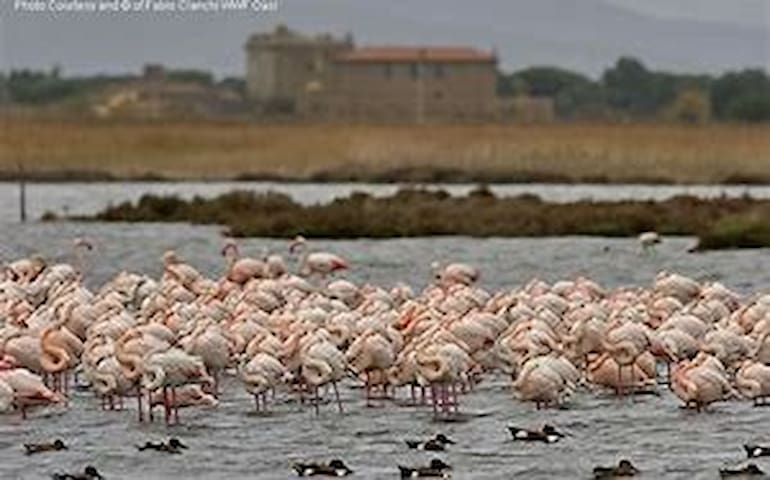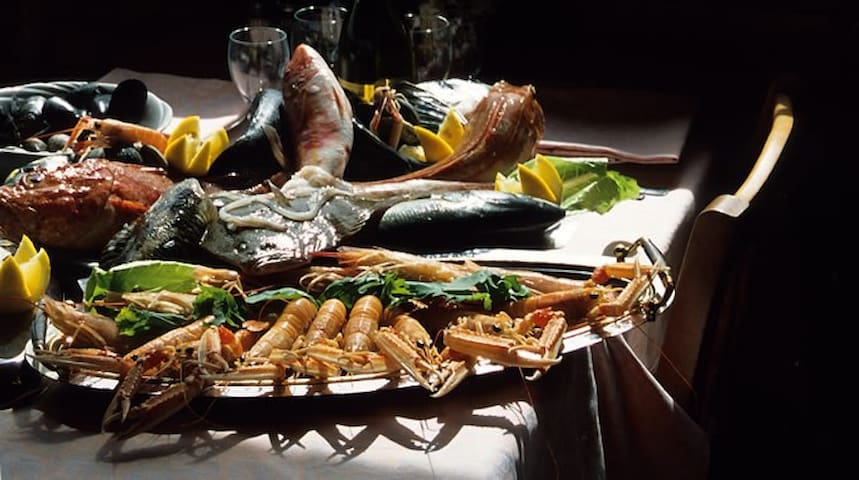Sightseening information
Arriving by car, from the descent that leads into the village, you can already admire a beautiful view of Porto Santo Stefano. The first thing you will encounter will be the shipyard, where the shipwrights give new life to authentic jewels of the sea. At this point, especially in high season, we advise you to leave your car in the parking lots and then continue on foot. Along the sea you will cross the whole of the port of the valley with the embarkations for the islands of Giglio and Giannutri, several boats and a fleet of fishing boats; if you arrive in the afternoon you may happen to witness the landing of fresh fish.
At the end of the port, the splendid Navigatori Promenade begins, designed by Giorgetto Giugiaro, which leads you to the small port of Pilarella. However, before continuing, you can cross the street and visit the Aquarium, where the typical Mediterranean marine environment is reproduced.
Back to the Lungomare, where the numerous benches facing the sea will allow you to take a break enjoying the spectacle of the Argentario Gulf that "looks" towards Talamone. At the end of the promenade you will arrive in Piazza dei Rioni which, facing the small harbor, we can call the "living room" of Porto Santo Stefano. A stop in the numerous bars and restaurants with a terrace overlooking the sea is a must, at any time of day, from breakfast to dinner, at night, the relaxing atmosphere of this place gives you some really pleasant moments. In summer you will also enjoy watching the local children who dive repeatedly into the waters of this small port.
Climb up through the picturesque alleys and stairways of the historic center to reach the Spanish Fortress. Situated in a dominant position over the town, it was built to control the port in the 17th century during the Spanish rule. The building is in perfect condition, houses the permanent exhibitions "Memories Submerged and Masters of Ax" and from its terraces you can admire a panorama of extraordinary beauty. The climb is not long but definitely steep, so we advise you not to tackle it during the hottest hours of the day or if you have problems walking.
142 habitants recommandent
Porto Santo Stefano
Arriving by car, from the descent that leads into the village, you can already admire a beautiful view of Porto Santo Stefano. The first thing you will encounter will be the shipyard, where the shipwrights give new life to authentic jewels of the sea. At this point, especially in high season, we advise you to leave your car in the parking lots and then continue on foot. Along the sea you will cross the whole of the port of the valley with the embarkations for the islands of Giglio and Giannutri, several boats and a fleet of fishing boats; if you arrive in the afternoon you may happen to witness the landing of fresh fish.
At the end of the port, the splendid Navigatori Promenade begins, designed by Giorgetto Giugiaro, which leads you to the small port of Pilarella. However, before continuing, you can cross the street and visit the Aquarium, where the typical Mediterranean marine environment is reproduced.
Back to the Lungomare, where the numerous benches facing the sea will allow you to take a break enjoying the spectacle of the Argentario Gulf that "looks" towards Talamone. At the end of the promenade you will arrive in Piazza dei Rioni which, facing the small harbor, we can call the "living room" of Porto Santo Stefano. A stop in the numerous bars and restaurants with a terrace overlooking the sea is a must, at any time of day, from breakfast to dinner, at night, the relaxing atmosphere of this place gives you some really pleasant moments. In summer you will also enjoy watching the local children who dive repeatedly into the waters of this small port.
Climb up through the picturesque alleys and stairways of the historic center to reach the Spanish Fortress. Situated in a dominant position over the town, it was built to control the port in the 17th century during the Spanish rule. The building is in perfect condition, houses the permanent exhibitions "Memories Submerged and Masters of Ax" and from its terraces you can admire a panorama of extraordinary beauty. The climb is not long but definitely steep, so we advise you not to tackle it during the hottest hours of the day or if you have problems walking.
BIKES
Those who wish to go for an easy ride with the family, can hire bikes at Feniglia Tombolo, and bike along the beach or ride the 20 kms to circumnavigate the Orbetello Lagoon. Enduro bike lovers can enjoy the hi-tech downhill. Road bike lovers can take the road connecting Porto S. Stefano and Porto Ercole and pedal uphill from the Passionists Convent to the Punta Telegrafo. The temperate climate permits outdoors sport all year round.
25 habitants recommandent
Lagoon of Orbetello
BIKES
Those who wish to go for an easy ride with the family, can hire bikes at Feniglia Tombolo, and bike along the beach or ride the 20 kms to circumnavigate the Orbetello Lagoon. Enduro bike lovers can enjoy the hi-tech downhill. Road bike lovers can take the road connecting Porto S. Stefano and Porto Ercole and pedal uphill from the Passionists Convent to the Punta Telegrafo. The temperate climate permits outdoors sport all year round.
Sea and beach
Anyone who is familiar with sea, knows well that there is no day alike the one before. Its moods and colours change unceasingly and reveal shades and colour effects to the observor's eye, immortalized only by the click of the camera. The deep emerald green tones of a warm summer day merge the endless hues that turn the sky azure blue in the intense blues of the silences and stillness of the depths. These are the sensations that Argentario, the land of water, imprints on the visitor's mind. Let your eyes close for a second and be caressed by the colours...
Starting from the south coast of Maremma Tuscany, we go up north and meet, one by one, the main seaside resorts and beaches of the Maremma: Capalbio beach, Ansedonia beach, Giannutri Island, Giglio Island beaches, Argentario beaches, Orbetello beaches, Talamone beaches, Cala di Forno, Collelungo beach, Marina di Alberese beach, Marina di Grosseto beach, Castiglione della Pescaia beaches, Rocchette beach, Punta Ala beach, Scarlino beaches, Follonica Beaches and Castiglioncello beaches.
166 habitants recommandent
Monte Argentario
Anyone who is familiar with sea, knows well that there is no day alike the one before. Its moods and colours change unceasingly and reveal shades and colour effects to the observor's eye, immortalized only by the click of the camera. The deep emerald green tones of a warm summer day merge the endless hues that turn the sky azure blue in the intense blues of the silences and stillness of the depths. These are the sensations that Argentario, the land of water, imprints on the visitor's mind. Let your eyes close for a second and be caressed by the colours...
Starting from the south coast of Maremma Tuscany, we go up north and meet, one by one, the main seaside resorts and beaches of the Maremma: Capalbio beach, Ansedonia beach, Giannutri Island, Giglio Island beaches, Argentario beaches, Orbetello beaches, Talamone beaches, Cala di Forno, Collelungo beach, Marina di Alberese beach, Marina di Grosseto beach, Castiglione della Pescaia beaches, Rocchette beach, Punta Ala beach, Scarlino beaches, Follonica Beaches and Castiglioncello beaches.
Offerta gastronomica
Tuscan cuisine is rich in taste, flavors and ancient traditions. Especially when it comes to his desserts. In Maremma, for example, at the end of each meal, you cannot miss a taste of the typical Sfratto, a sweet made from nuts and honey. Its name originates from the history of the Jewish community of Pitigliano which recalls the local custom of beating Jews at the door with a stick.
Today the "eviction" of the Goym is a specialty of villages of Pitigliano and Sorano and is tasted especially at Christmas time, cut into slices.
From the happy encounter between the kitchens of the two peoples come the dish "tegamata", a stew of beef, tomato and potatoes, the "Esaù lentil soup", which recalls a recipe mentioned in the Old Testament, risotto with artichokes.
Another must of the territory is the Maremma tortelli, a very well-known dish throughout Tuscany. Egg pasta is spread by hand and the filling is made with ricotta cheese and spinach. They can be seasoned with meat sauce or with butter and sage. In some areas of the Maremma, for example in Sorano, a pinch of cinnamon is often added to enhance the contrast between sweet and savory.
Tortelli pair beautifully with local wines, such as Morellino di Scansano or Bianco di Pitigliano.
Absolutely to taste is also acquacotta, a recipe that represents the history and tradition of the Maremma. At first glance, it may seem similar to ribollita but with some difference. Acquacotta is a soup of poor and peasant origins that can contain various vegetables, including beets, tomatoes and carrots. It is accompanied by croutons and a poached egg
And then the fish dishes like the Scaveccio, made with so-called poor fish because they are full of thorns and not very marketable (boga, horse mackerel, sparaglione); these are marinated so as to soften the thorns and make them appetizing with taste.
Or seafood salads, noodles with scampi, risotto with mussels (crabs) or bottarga di Orbetello.
In other words, for all taste
166 habitants recommandent
Monte Argentario
Tuscan cuisine is rich in taste, flavors and ancient traditions. Especially when it comes to his desserts. In Maremma, for example, at the end of each meal, you cannot miss a taste of the typical Sfratto, a sweet made from nuts and honey. Its name originates from the history of the Jewish community of Pitigliano which recalls the local custom of beating Jews at the door with a stick.
Today the "eviction" of the Goym is a specialty of villages of Pitigliano and Sorano and is tasted especially at Christmas time, cut into slices.
From the happy encounter between the kitchens of the two peoples come the dish "tegamata", a stew of beef, tomato and potatoes, the "Esaù lentil soup", which recalls a recipe mentioned in the Old Testament, risotto with artichokes.
Another must of the territory is the Maremma tortelli, a very well-known dish throughout Tuscany. Egg pasta is spread by hand and the filling is made with ricotta cheese and spinach. They can be seasoned with meat sauce or with butter and sage. In some areas of the Maremma, for example in Sorano, a pinch of cinnamon is often added to enhance the contrast between sweet and savory.
Tortelli pair beautifully with local wines, such as Morellino di Scansano or Bianco di Pitigliano.
Absolutely to taste is also acquacotta, a recipe that represents the history and tradition of the Maremma. At first glance, it may seem similar to ribollita but with some difference. Acquacotta is a soup of poor and peasant origins that can contain various vegetables, including beets, tomatoes and carrots. It is accompanied by croutons and a poached egg
And then the fish dishes like the Scaveccio, made with so-called poor fish because they are full of thorns and not very marketable (boga, horse mackerel, sparaglione); these are marinated so as to soften the thorns and make them appetizing with taste.
Or seafood salads, noodles with scampi, risotto with mussels (crabs) or bottarga di Orbetello.
In other words, for all taste



